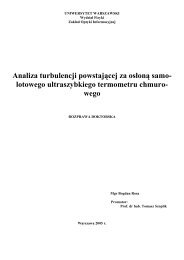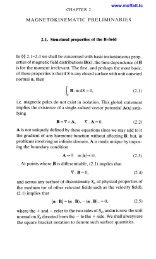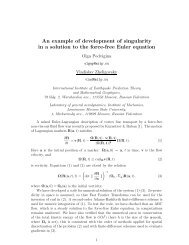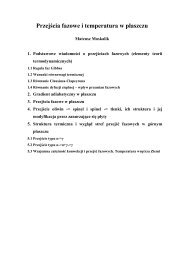A similarity solution for viscous source flow on a vertical plane
A similarity solution for viscous source flow on a vertical plane
A similarity solution for viscous source flow on a vertical plane
Create successful ePaper yourself
Turn your PDF publications into a flip-book with our unique Google optimized e-Paper software.
46 B. R. Duffy and H. K. Moffatt<br />
The natural scaling <str<strong>on</strong>g>for</str<strong>on</strong>g> the problem follows from the definiti<strong>on</strong> of the volume flux, and<br />
from the assumpti<strong>on</strong>s that there is a <str<strong>on</strong>g>viscous</str<strong>on</strong>g>-gravitati<strong>on</strong>al balance in the downstream<br />
directi<strong>on</strong>, and that the pressure variati<strong>on</strong>s in the transverse directi<strong>on</strong> scale with surface<br />
tensi<strong>on</strong>:<br />
where<br />
(x, y, z) X s<br />
(x , δy , εδz), (u, , w) U s<br />
(u , δ , εδw ), p Π s<br />
p , h εδX s<br />
h ,<br />
δ <br />
µQγ<br />
(ρg sin α) X s<br />
/ ,<br />
(ρg sin α) µ Q<br />
ε γX s<br />
/ ,<br />
(ρg sin α) Q<br />
U s<br />
µγX s<br />
/ (ρg sin α) µ Q γ<br />
, Π s<br />
X s<br />
/ .<br />
Here u, and w denote the Cartesian velocity comp<strong>on</strong>ents, p denotes the fluid pressure<br />
relative to atmospheric pressure, and X s<br />
is a measure of distance downstream from the<br />
<str<strong>on</strong>g>source</str<strong>on</strong>g>. X s<br />
need not be defined too precisely, since any length scale selected will be artificial<br />
in the sense that it will not appear in the <str<strong>on</strong>g>soluti<strong>on</strong></str<strong>on</strong>g> (cf. Smith, 1973, p. 276).<br />
The c<strong>on</strong>tinuity and Navier–Stokes equati<strong>on</strong>s then lead to<br />
u x<br />
y<br />
w z<br />
0,<br />
R(uu x<br />
u y<br />
wu z<br />
) δ p x<br />
1δ ε u xx<br />
ε u yy<br />
u zz<br />
,<br />
R(u x<br />
y<br />
w z<br />
) p y<br />
δ ε xx<br />
ε yy<br />
zz<br />
,<br />
Rε(uw x<br />
w y<br />
ww z<br />
) p z<br />
δ ε w xx<br />
ε w yy<br />
ε w zz<br />
(ρg cos αγ) δ X s<br />
,<br />
overbars having dropped <str<strong>on</strong>g>for</str<strong>on</strong>g> clarity; here<br />
R ρU s X ε δ<br />
s<br />
µ<br />
<br />
ρ gQ<br />
µ γ X s<br />
/ .<br />
We now take δ 1, ε 1 and R 1 (all of which should be valid <str<strong>on</strong>g>for</str<strong>on</strong>g> sufficiently large X s<br />
).<br />
Then <str<strong>on</strong>g>for</str<strong>on</strong>g> sufficiently small α <br />
π we have, at leading order,<br />
u zz<br />
1, zz<br />
p y<br />
, 0p z<br />
.<br />
This system is to be integrated subject to the boundary c<strong>on</strong>diti<strong>on</strong>s<br />
and, at leading order,<br />
u 0 <strong>on</strong> z0,<br />
u z<br />
z<br />
0 and p h yy<br />
<strong>on</strong> z h.<br />
We thus find<br />
p h yy<br />
, u hz <br />
z, h yyy<br />
(hz <br />
z).<br />
Then, <str<strong>on</strong>g>for</str<strong>on</strong>g> example, integrati<strong>on</strong> of the c<strong>on</strong>tinuity equati<strong>on</strong> and use of the c<strong>on</strong>diti<strong>on</strong>s<br />
w 0 <strong>on</strong> z0, w uh x<br />
h y<br />
<strong>on</strong> z h<br />
leads to 3h h x<br />
(h h yyy<br />
) y<br />
,<br />
which is (2.2) is n<strong>on</strong>-dimensi<strong>on</strong>al <str<strong>on</strong>g>for</str<strong>on</strong>g>m.


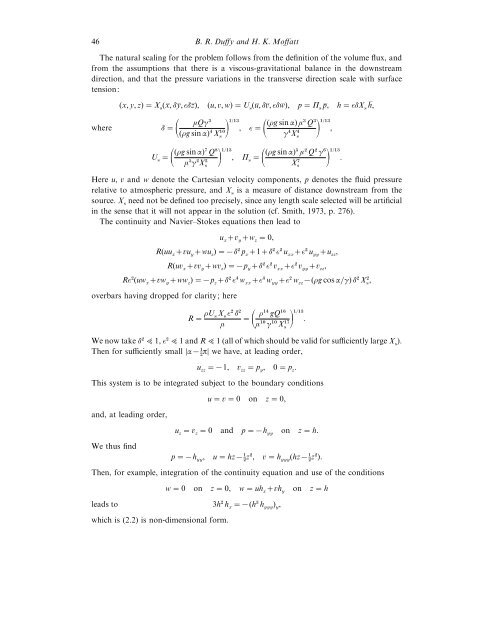


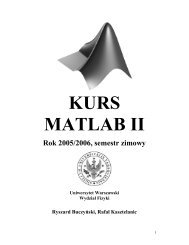
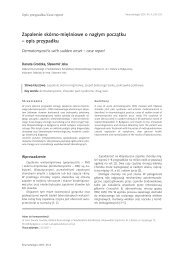
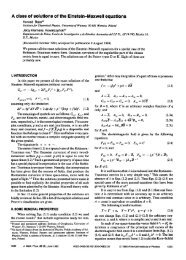

![slajdy [PDF, 0,6 MiB] - Instytut Geofizyki](https://img.yumpu.com/22546539/1/190x143/slajdy-pdf-06-mib-instytut-geofizyki.jpg?quality=85)
